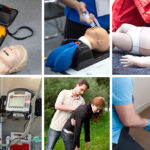Cardiac arrest is an electrical misfiring in the heart resulting in an irregular beat that disrupts blood flow to vital organs. Every year in the United States, there are over 475,000 cardiac arrests, with 350,000 occurring outside of a medical facility, leaving victims stranded with no doctor in sight. But immediate administration of CPR can double or even triple the chances of survival. Cardiac arrest is an agonizing and slow way to die and is sadly a leading cause of death in America, however, bystander CPR administration can increase survivorship rates up to 45%. Use of Automated External Defibrillators (AEDs) improves recovery rates from 2% to over 80% with proper and prompt administration. Help is needed immediately and proper training is crucial in those seconds; anyone can learn how to save the life of a person suffering from cardiac arrest. This is the goal of the American CPR Care Association.
What is the CPR/ AED course?
The CPR/AED course offered by American CPR Care Association is an online video-based guided training that teaches adults and children alike how to save a person suffering from cardiac arrest. This course is designed to develop the skills needed to effectively respond in an emergency situation in accordance with the Emergency Cardiovascular Care (ECC) and AHA’s 2015 CPR Guidelines. It teaches proper chest compression technique and correct administration of a defibrillator.
Why is it important?
- The majority of cardiac arrests occur at home and over 70% outside of a hospital. Should you be called upon to help a victim, it’s likely to be a loved one.
- Many Americans report feeling helpless to provide aid in the event of a loved one suffering from cardiac arrest.
- Immediate care can be the difference between life and death for a victim of cardiac arrest, up to 45% of cardiac arrest victims survive when bystander CPR is administered.
- AEDs restore normal heart rhythm quickly and safely with little need for medical training. The chance of survival can decrease by up to 10% per minute without defibrillation.
- Confidence in one’s CPR/AED skills can increase the survival rate of the patients and reduces the risk of further complications.
What do I do when someone is suffering from cardiac arrest?
- Remain calm, get to the nearest phone and call 911.
- After confirming EMTs are on their way and the scene is safe, approach the person and get their attention by tapping their shoulder and asking if they need help, if needed move the victim clear of water and ensure they are lying face up.
- With the victim lying on their back, tilt their head back to ensure their away is open, in conventional CPR you would check for breathing to determine the need for rescue breathing before moving to chest compressions.
- To administer chest compressions, clasp your hands one on top of the other in the center of the victim’s chest, elbow extended and locked, before pressing down with your full body weight to a depth of two inches.
- To determine correct pacing, imagine the beat of a fast song like Bee Gee’s classic “Stayin’ Alive,” Journey’s “Don’t Stop Believing,” or Queen’s “Another One Bites the Dust” and proceed to pump your arms up and down to the beat of the song.
- Continue pumping at 100 to 120 beats per minute (to the beat of the song) for at least thirty compressions, if rescue breathing is required administer two breaths, ensuring their chest rises with each breath. For every 30 chest compression, 2 sets of rescue breaths should be performed.
- Alternately chest compression and rescue breathing until normal heart rhythm and breathing is established, an AED is made available or medical services have arrived. Remember the ratio 30:2.
- If using an AED follow the audio/visual prompts, open the victim’s shirt and place the pads on their chest according to the diagram printed on the unit, and follow instructions included in the unit and training provided in the course.
- After the AED administers the shock, or if no shock is advised, resume CPR until signs of life appear or medical help arrives.
Conclusion
In times of great distress, we cannot rely on a savior to rescue us, we must be our own heroes. Each individual has the capacity to be a hero, to prolong life, to ensure that a parent is given another day to hug their children. Register today for the CPR course and save lives of your loved ones.







